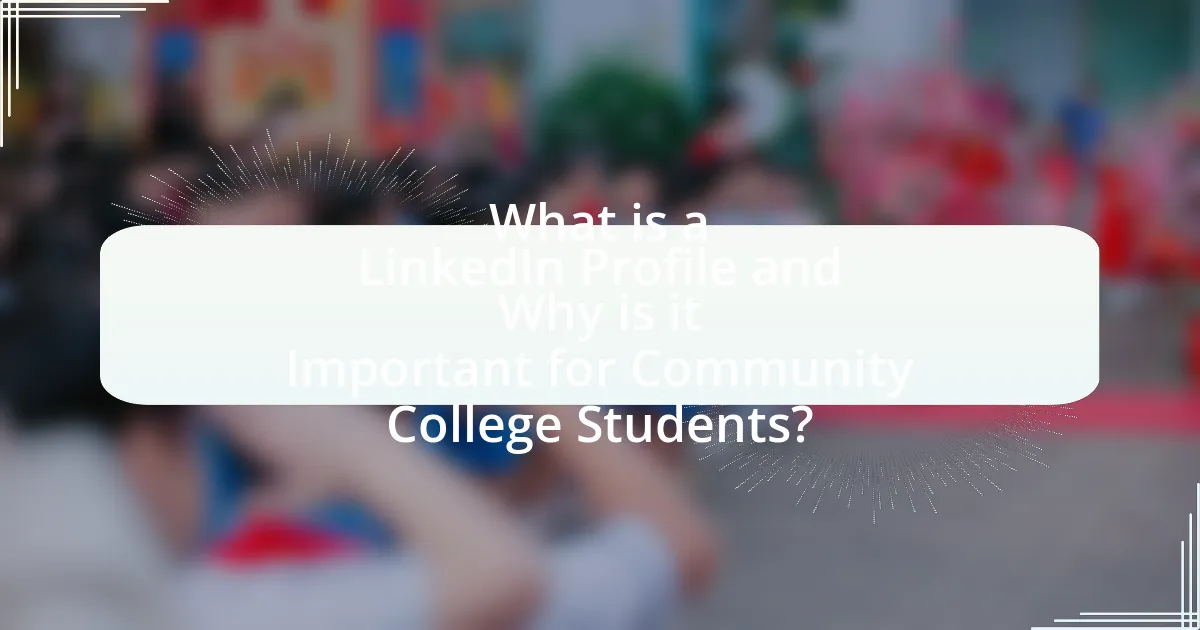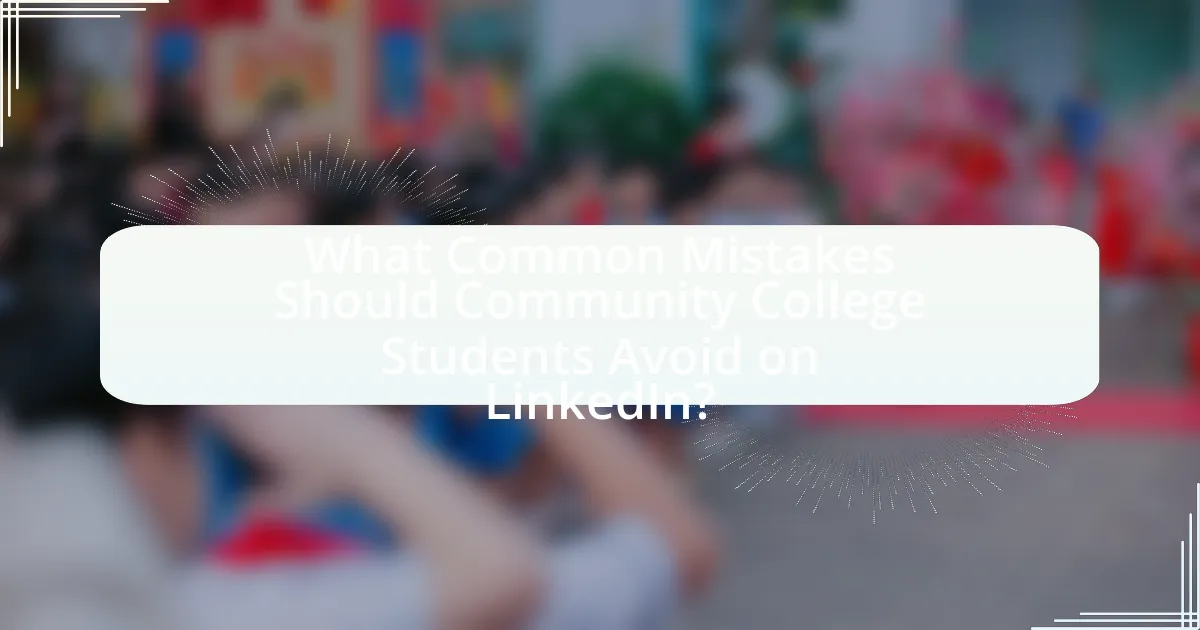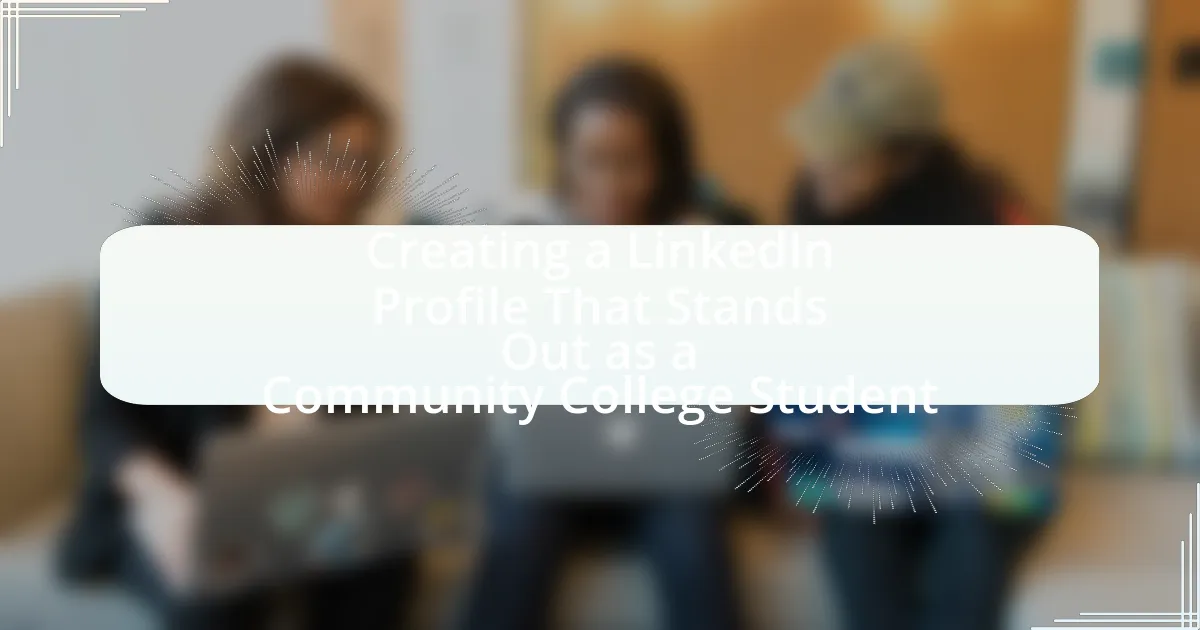Creating a LinkedIn profile is essential for community college students seeking to enhance their professional presence and career opportunities. This article outlines the importance of a well-crafted LinkedIn profile, highlighting its role in increasing visibility to potential employers, facilitating networking, and providing access to job postings and internships. Key elements of an effective profile include a professional photo, a compelling headline, and a detailed summary that showcases skills and experiences. Additionally, the article discusses strategies for optimizing profiles, avoiding common mistakes, and leveraging endorsements and recommendations to maximize career prospects.

What is a LinkedIn Profile and Why is it Important for Community College Students?
A LinkedIn profile is a professional online presence that allows individuals to showcase their skills, experiences, and education to potential employers and networking contacts. For community college students, having a LinkedIn profile is important because it enhances their visibility in the job market, facilitates networking opportunities, and provides access to job postings and internships. According to a survey by Jobvite, 87% of recruiters use LinkedIn to find candidates, highlighting the platform’s significance in career development. Additionally, a well-crafted LinkedIn profile can help community college students connect with industry professionals and alumni, which can lead to mentorship and job opportunities.
How can a strong LinkedIn profile enhance career opportunities for students?
A strong LinkedIn profile enhances career opportunities for students by increasing visibility to potential employers and networking contacts. A well-crafted profile showcases a student’s skills, experiences, and accomplishments, making them more attractive candidates. According to a survey by Jobvite, 87% of recruiters use LinkedIn to find candidates, highlighting the platform’s significance in job searches. Additionally, students with complete profiles receive 40 times more opportunities through LinkedIn, as reported by LinkedIn itself. This demonstrates that an effective profile not only attracts attention but also facilitates connections that can lead to internships and job offers.
What specific advantages does LinkedIn offer to community college students?
LinkedIn offers community college students several specific advantages, including networking opportunities, access to job postings, and the ability to showcase skills and achievements. Networking on LinkedIn allows students to connect with industry professionals, alumni, and potential employers, which can lead to internships and job opportunities. The platform features a vast array of job postings tailored to various skill levels, making it easier for students to find positions that match their qualifications. Additionally, students can create a professional profile that highlights their education, projects, and skills, which enhances their visibility to recruiters and hiring managers. These advantages collectively support community college students in building their professional identities and advancing their careers.
How does networking on LinkedIn differ from traditional networking?
Networking on LinkedIn differs from traditional networking primarily in its scale and accessibility. LinkedIn allows users to connect with a vast number of professionals globally, transcending geographical limitations, whereas traditional networking often relies on in-person interactions within local communities or specific events. Additionally, LinkedIn provides tools such as endorsements, recommendations, and a digital portfolio that enhance professional visibility and credibility, which are not typically available in traditional networking settings. This digital platform enables users to engage with industry-specific content and communities, facilitating connections based on shared interests and professional goals rather than solely on personal introductions.
What are the key elements of an effective LinkedIn profile?
An effective LinkedIn profile includes a professional photo, a compelling headline, a detailed summary, relevant work experience, and skills endorsements. A professional photo enhances first impressions, while a compelling headline succinctly conveys your professional identity. A detailed summary allows you to showcase your background, aspirations, and unique value proposition. Relevant work experience demonstrates your qualifications and achievements, and skills endorsements from connections validate your expertise. According to LinkedIn data, profiles with photos receive 21 times more profile views and 36 times more messages, underscoring the importance of these elements in attracting attention and opportunities.
What role does a professional photo play in a LinkedIn profile?
A professional photo plays a crucial role in a LinkedIn profile by significantly enhancing the user’s credibility and approachability. Research indicates that profiles with professional photos receive 14 times more profile views and 36 times more messages than those without. This visual representation helps to establish a positive first impression, making it easier for potential employers and connections to engage with the individual. Furthermore, a well-chosen professional photo aligns with the overall branding of the user, reinforcing their professional identity in the competitive job market.
How should a community college student craft their headline and summary?
A community college student should craft their LinkedIn headline to clearly reflect their current educational status and career aspirations, while the summary should provide a concise overview of their skills, experiences, and goals. The headline should include the student’s major or field of study, along with a key skill or career objective, such as “Aspiring Graphic Designer | Community College Student in Visual Arts.” The summary should expand on this by detailing relevant coursework, projects, internships, and any extracurricular activities that demonstrate their commitment and skills, ideally in a narrative format that connects their past experiences to their future ambitions. This approach is effective because it aligns with LinkedIn’s professional networking purpose, allowing students to present themselves as motivated individuals ready to enter the workforce.

How can Community College Students Create a Standout LinkedIn Profile?
Community college students can create a standout LinkedIn profile by focusing on a professional photo, a compelling headline, and a detailed summary that highlights their skills and experiences. A professional photo increases profile views by 14 times, while a strong headline that includes relevant keywords can attract potential employers. Additionally, a well-crafted summary should showcase academic achievements, internships, volunteer work, and specific skills, making the profile more appealing to recruiters. Engaging with industry-related content and connecting with professionals in their field can further enhance visibility and networking opportunities.
What steps should students take to build their LinkedIn profile from scratch?
Students should take the following steps to build their LinkedIn profile from scratch: First, create a LinkedIn account by signing up with an email address and setting a strong password. Next, complete the profile by adding a professional photo, writing a compelling headline that reflects their career aspirations, and crafting a summary that highlights their skills and experiences. Students should then list their education, including their community college, relevant coursework, and any honors received.
Additionally, they should include work experience, internships, or volunteer activities, emphasizing transferable skills gained from these experiences. Students can enhance their profiles by obtaining endorsements and recommendations from peers or instructors, which can validate their skills. Finally, students should actively engage with content on LinkedIn by following industry leaders, joining relevant groups, and sharing articles or insights to demonstrate their knowledge and interests in their field.
How can students effectively showcase their education and skills?
Students can effectively showcase their education and skills by creating a comprehensive LinkedIn profile that highlights their academic achievements, relevant coursework, and practical experiences. A well-structured profile should include a professional photo, a compelling headline, and a detailed summary that outlines their goals and skills. Additionally, students should list their educational institutions, degrees earned, and any certifications obtained, while also incorporating specific projects or internships that demonstrate their competencies. According to LinkedIn’s own data, profiles with complete information receive 40% more opportunities, underscoring the importance of a thorough and engaging presentation of one’s educational background and skills.
What strategies can be used to highlight relevant experiences and projects?
To highlight relevant experiences and projects effectively, community college students should utilize specific strategies such as tailoring their LinkedIn profile to showcase skills and accomplishments directly related to their career goals. This involves using clear, action-oriented language to describe experiences, quantifying achievements with metrics when possible, and including keywords relevant to the desired industry to enhance searchability. For instance, a student can mention specific projects completed during coursework or internships, detailing their role and the impact of their contributions. This approach not only demonstrates practical experience but also aligns with employer expectations, as studies show that 70% of employers value relevant experience when evaluating candidates.
How can students optimize their LinkedIn profiles for visibility?
Students can optimize their LinkedIn profiles for visibility by ensuring their profiles are complete, using relevant keywords, and engaging with content. A complete profile includes a professional photo, a compelling headline, and a detailed summary that highlights skills and experiences. Incorporating industry-specific keywords in the summary and experience sections enhances searchability, as LinkedIn’s algorithm favors profiles that match user queries. Engaging with posts, joining relevant groups, and sharing insights can further increase visibility, as active participation signals to the platform that the user is an engaged member of the community. According to LinkedIn’s own data, profiles with a photo receive 21 times more profile views and 36 times more messages, underscoring the importance of a professional appearance for visibility.
What keywords should community college students include in their profiles?
Community college students should include keywords such as “community college,” “associate degree,” “transfer student,” “internship,” “career development,” “skills,” “networking,” and “professional experience” in their profiles. These keywords are essential as they reflect the educational background and career aspirations of community college students, making their profiles more searchable and relevant to potential employers and connections. Including these terms can enhance visibility on platforms like LinkedIn, where recruiters often search for candidates with specific qualifications and experiences.
How can students leverage endorsements and recommendations effectively?
Students can leverage endorsements and recommendations effectively by actively seeking and showcasing them on their LinkedIn profiles. By requesting endorsements from peers, instructors, and employers, students can highlight their skills and competencies, which enhances their credibility. Research indicates that profiles with endorsements receive 34 times more profile views and 36 times more messages, demonstrating the impact of social proof on professional networking. Additionally, personalized recommendations that detail specific achievements or experiences can significantly strengthen a student’s profile, making them more attractive to potential employers.

What Common Mistakes Should Community College Students Avoid on LinkedIn?
Community college students should avoid several common mistakes on LinkedIn to enhance their professional presence. One major mistake is having an incomplete profile; profiles with missing sections, such as a professional photo, summary, or work experience, are less likely to attract attention from potential employers. Additionally, students often neglect to customize their LinkedIn URL, which can make their profile harder to find and appear less professional.
Another common error is using a casual tone in their profile summary or posts, which can undermine their professionalism. Furthermore, failing to engage with relevant content or networks limits their visibility and opportunities for networking. Lastly, students frequently overlook the importance of tailoring their connection requests and messages, which can lead to missed networking opportunities. These mistakes can hinder their ability to stand out in a competitive job market.
What are the pitfalls of having an incomplete or unprofessional profile?
Having an incomplete or unprofessional profile can significantly hinder opportunities for networking and career advancement. An incomplete profile may lack essential information such as work experience, education, and skills, which can lead to potential employers or connections perceiving the individual as unqualified or disinterested. Research indicates that profiles with complete information receive 40% more opportunities than those that are incomplete. Additionally, an unprofessional profile, characterized by poor grammar, unprofessional photos, or inappropriate content, can damage credibility and deter potential employers. According to a survey by CareerBuilder, 70% of employers use social media to screen candidates, and 54% have decided not to hire a candidate based on their social media presence. Thus, maintaining a complete and professional profile is crucial for making a positive impression and maximizing career prospects.
How can students avoid oversharing personal information?
Students can avoid oversharing personal information by carefully selecting what details to include in their LinkedIn profiles. They should focus on professional achievements, skills, and experiences relevant to their career goals while omitting sensitive personal data such as home addresses, phone numbers, or personal anecdotes. Research indicates that maintaining privacy settings and being mindful of the audience can significantly reduce the risk of oversharing, as 70% of LinkedIn users prefer to keep their profiles professional and focused on career-related content.
What are the consequences of neglecting profile updates?
Neglecting profile updates can lead to reduced visibility and missed opportunities on LinkedIn. An outdated profile may not accurately reflect current skills, experiences, or achievements, which can hinder networking and job prospects. According to LinkedIn data, profiles that are regularly updated receive 18 times more profile views and 36 times more messages from recruiters compared to those that are not. This demonstrates that maintaining an up-to-date profile is crucial for maximizing engagement and career advancement.
How can students maintain an active presence on LinkedIn?
Students can maintain an active presence on LinkedIn by regularly updating their profiles, engaging with content, and networking with professionals. Regularly updating profiles ensures that students showcase their latest skills, experiences, and accomplishments, which is crucial as 87% of recruiters use LinkedIn to evaluate candidates. Engaging with content, such as liking, commenting, and sharing relevant posts, helps students stay visible in their network and demonstrates their interests and expertise. Networking with professionals through connection requests and informational interviews fosters relationships that can lead to job opportunities, as 70% of jobs are found through networking.
What types of content should community college students share or engage with?
Community college students should share or engage with content that highlights their academic achievements, skills, internships, and professional development opportunities. This includes posting about completed projects, certifications, relevant coursework, and participation in extracurricular activities. Engaging with industry-related articles, networking opportunities, and discussions on career advice can also enhance their visibility and connections on platforms like LinkedIn. Research indicates that profiles showcasing specific skills and experiences attract more attention from employers, making it crucial for students to curate their content strategically.
How can students effectively connect with industry professionals?
Students can effectively connect with industry professionals by utilizing LinkedIn to create a compelling profile that highlights their skills, experiences, and aspirations. A well-crafted LinkedIn profile, which includes a professional photo, a strong headline, and a detailed summary, increases visibility and attracts the attention of industry professionals. According to LinkedIn statistics, profiles with photos receive 21 times more profile views and 36 times more messages, demonstrating the importance of a professional appearance. Additionally, students should actively engage with industry-related content by sharing articles, commenting on posts, and joining relevant groups, which fosters connections and showcases their interest in the field. Networking through LinkedIn can lead to valuable opportunities, as 70% of jobs are found through networking, emphasizing the platform’s effectiveness in connecting students with professionals.
What are the best practices for using LinkedIn as a community college student?
The best practices for using LinkedIn as a community college student include creating a professional profile, engaging with relevant content, and networking strategically. A professional profile should feature a clear photo, a compelling headline, and a detailed summary that highlights academic achievements and career aspirations. Engaging with content involves sharing articles, commenting on posts, and participating in discussions related to your field of study, which can enhance visibility and demonstrate expertise. Networking strategically means connecting with classmates, professors, and industry professionals, as studies show that 85% of jobs are filled through networking. By following these practices, community college students can effectively leverage LinkedIn to build their professional presence and opportunities.
How can students set specific goals for their LinkedIn usage?
Students can set specific goals for their LinkedIn usage by identifying clear objectives such as expanding their professional network, showcasing their skills, or securing internships. For instance, a student may aim to connect with at least five industry professionals each month to enhance networking opportunities. Additionally, students can focus on updating their profiles regularly with relevant coursework and projects to attract potential employers. Research indicates that profiles with complete information receive 40 times more opportunities, emphasizing the importance of goal-oriented profile management.
What tips can help students make the most of LinkedIn groups and discussions?
To make the most of LinkedIn groups and discussions, students should actively participate by sharing insights and asking questions relevant to their field of study. Engaging in discussions not only showcases their knowledge but also helps build connections with industry professionals. Additionally, students should join groups that align with their career interests, as this allows them to access valuable resources and networking opportunities. According to LinkedIn’s own data, members who engage in groups are 70% more likely to receive job opportunities, highlighting the importance of active participation in these communities.

Leave a Reply